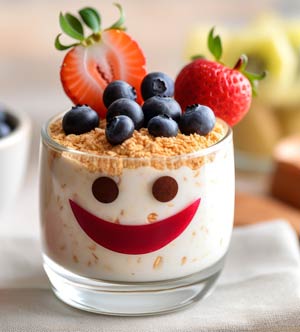
 |
|
||||||||||||
 |
 |
 |
 |
|||
Kids Are What They Eat, Too |
 |
|
Kids Are What They Eat, Too |
|
Just like adults, focusing on wellness for kids means balancing their physical and mental health. Parents face the challenge of ensuring their children eat a nutritious diet and exercise regularly — all while juggling hectic family schedules! Here are some tips to help you get kids of all ages to eat the recommended daily amount of right number of servings of whole grains, fresh fruits and vegetables, protein and fat-free/low-fat dairy products as well as getting the recommended amount of exercise.
Where Does it Begin? Start introducing good nutrition as soon as solid foods are on the menu. (Just make sure to check with your baby’s doctor about the types and timings of the foods you introduce.) You can offer healthy options such as mashed avocado, banana, strained vegetables and whole grains such as oatmeal. And these early efforts might be the start some healthy habits! Encourage Adventurous Eating No matter their age, you want to encourage children to try new, healthy foods. Let kids know that “healthy” doesn’t mean it tastes bad, and remember, it might take a few tries before they can decide whether they like that new food. Be sure to let them know it’s okay if they don’t like some foods they try. When you introduce a new food, set the stage. Try serving the new item along with one or two other foods you know your child loves. You can also help your child get into the habit of eating something different by not serving the same food two days in a row. If they had carrots with their lunch yesterday be sure to offer a different vegetable today along with a promise that carrots will be back on the menu soon. Make choosing a healthy option easier for your kids by buying only the kinds of food you want them to eat. Keep plenty of washed fruit, cut-up vegetables, whole grains and healthy nuts at the ready. That way, when they’re old enough to put their own snacks together, healthy options are always waiting for them. What to Serve Serve fruits and vegetables every day, aiming for everyone to get their five servings. Offer low fat/no fat dairy products and healthy fats like avocados, olive oil and some nuts. Choose whole-grain cereals and whole/multigrain breads. Remember to include lean meats and other good sources of protein such as fish, eggs, beans and nuts. And encourage everyone to drink water by filling water bottles for kids to take to school and activities. To eliminate temptation, avoid keeping sugary drinks in your house.
Make it Fun! Eat meals together — regularly — as a family to improve everyone’s physical and mental well-being. Take a look at this article, “7 Science-Based Benefits of Eating Together as a Family,” from Parents magazine that explains the positive outcomes of sharing meals. You can make a shared meal even more fun by letting each person at the table take a turn picking the nightly topic of conversation. If your family schedule is too busy around dinner time, make your family meal lunch or breakfast! Find ways to include your kids in making meals. Little ones can add raisins or pre-chopped apples to their morning cereal and help choose which vegetables to add to lunch or dinner! This can become a fun bonding time, and they’ll be more inclined to eat what they’ve helped make. For older kids, set out the fixings for a burrito bowl using leftover chicken, fish or beans, brown rice, salsa and low-fat shredded cheese and let everyone create their own bowl. Or have them help you make a stir fry using left-over protein and veggies and serve it over brown rice or whole wheat noodles. Make Healthy Swaps Try adding spices such as cinnamon or ginger, or even try garlic or vanilla to enhance flavors and decrease the amount of sugar and salt. If your kid is craving a little sweetness, add a fruit topping to oatmeal or try a drizzle of maple syrup or honey instead of sugar. If your teenager barely has enough time to make it to school and won’t get up early enough to have breakfast, try making a smoothie with low-fat yogurt, fresh or frozen fruit and maybe some greens or natural nut butter for an on-the-go meal. A smoothie is a great convenient way for them to get some of the recommended servings of fruits and vegetables! Keep it Moving
When exercising with your kids, make it fun! Let them choose the activity — hopscotch, tag, frisbee or an after-dinner walk. Remember, family exercise time is about instilling a love of movement and building family bonds! To help you get started, watch for PATH family challenges, such as our current Healthy Habit Fun Family Fitness challenge, running March 24 – 30. If you answer “Yes” to exercising with your kids five out of seven days that week, you win the challenge and earn 200 PATH points. If you’re interested in learning more about recommendations for physical and mental well-being for children and adolescents, check out these resources: |
|
 If you find a few healthy meals your family loves, make a double batch, so you have leftovers for lunch, dinner — or even breakfast! Add a different side dish each night, such as a salad or fresh vegetables, to make it interesting.
If you find a few healthy meals your family loves, make a double batch, so you have leftovers for lunch, dinner — or even breakfast! Add a different side dish each night, such as a salad or fresh vegetables, to make it interesting. Exercise is crucial in helping children and adolescents maintain their physical and mental health. And making exercise part of your family routine helps guarantee success for everyone! Exercise helps to:
Exercise is crucial in helping children and adolescents maintain their physical and mental health. And making exercise part of your family routine helps guarantee success for everyone! Exercise helps to: